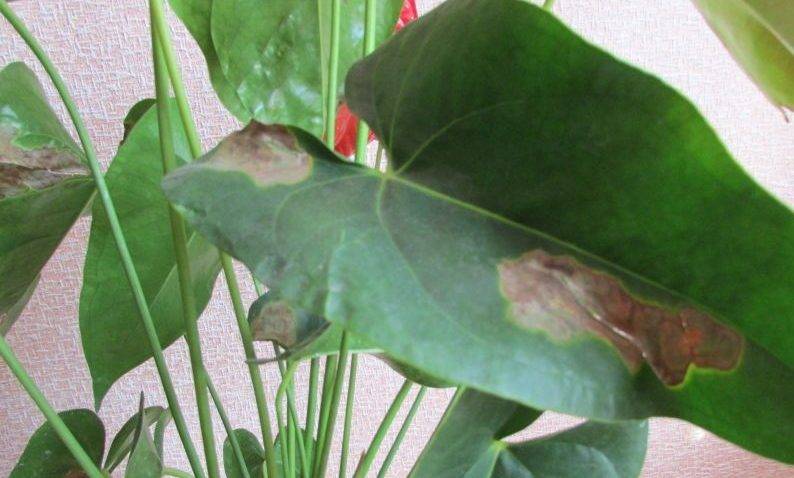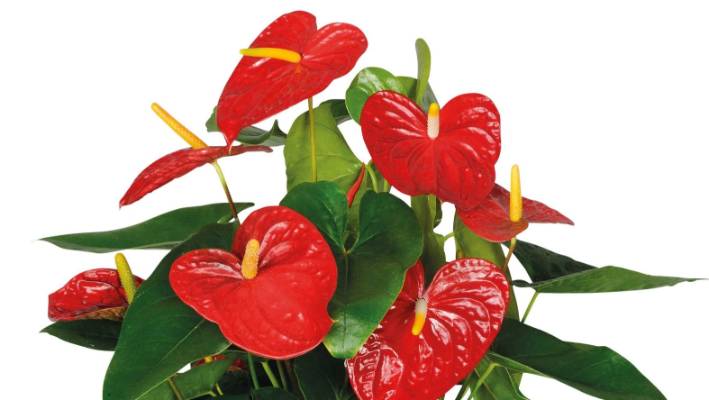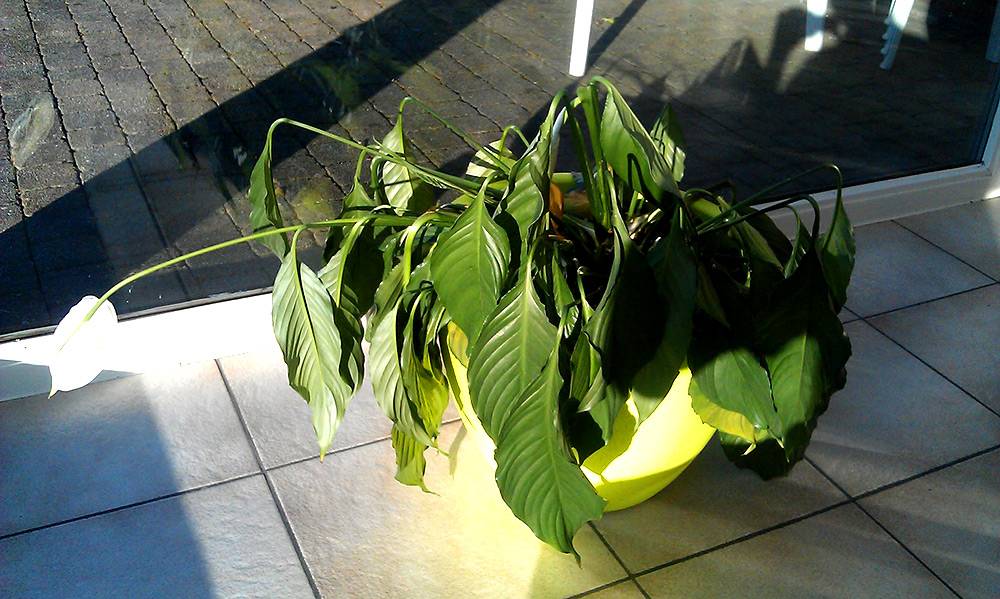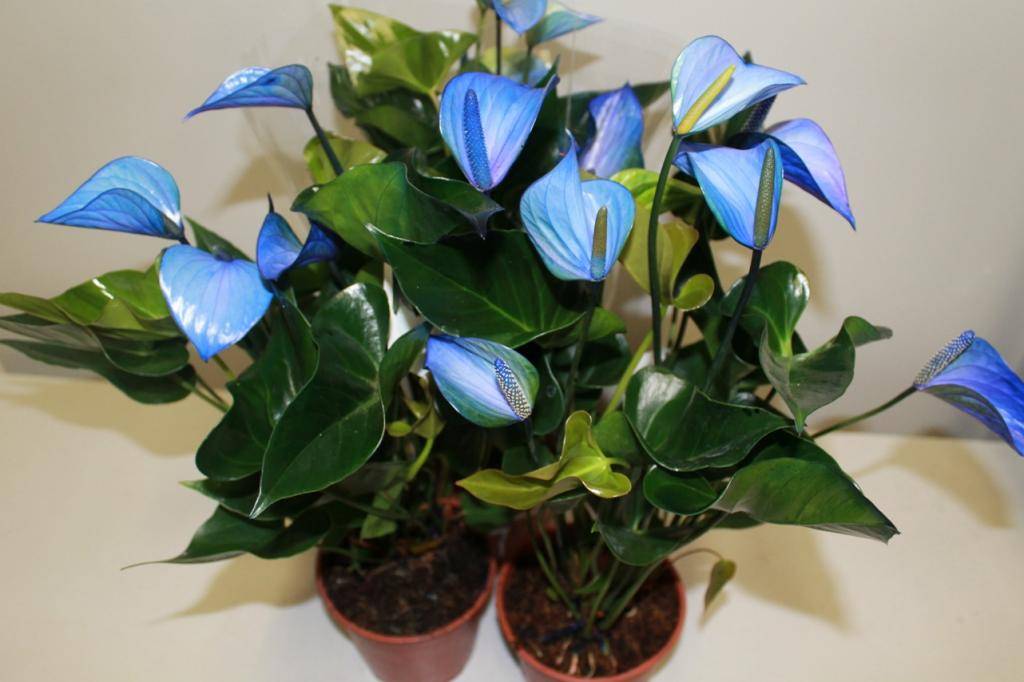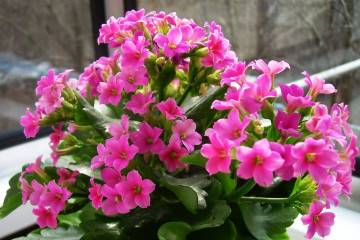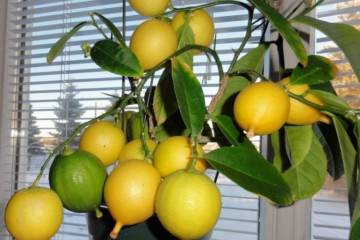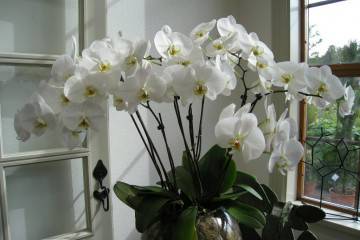Anthurium has brown spots on the leaves - causes and treatment
Content:
Anthurium, or male happiness, is a rather difficult and capricious flower to care for. Almost all gardeners at least once faced this problem: anthurium has brown spots on the leaves. This sign indicates improper care, the presence of a factor that negatively affects the condition of the plant.
Why does the flower "male happiness" have brown spots on the leaves?
There are many reasons for the appearance of brown spots on the leaf plates.
Overflow
Anthurium loves abundant watering, but it is afraid of overflow no less than a prolonged drought. In order to properly water the plant, you must always focus on the condition of the soil - it must dry out between wetting.
In summer, watering is carried out every 3 days; in winter, it is enough to moisten the plant once a week.
Watering with cold water
The leaves can dry out due to use for watering and spraying with cold water. The liquid must be clean, soft and always at room temperature.
Unsuitable soil
Dark spots may appear due to improperly selected soil:
- an excess of calcium salts;
- high acidity.
It is recommended to choose specialized purchased land for planting. You can compose the soil yourself by mixing leaf humus and peat in equal proportions and adding a small amount of sand.
Incorrect fertilization can provoke brown spotting. The plant needs mineral or organic feeding every 2 weeks during the period of active growth and flowering. Both the lack of dressings and their excessive amount are destructive.
Low room temperature
At low temperatures, leaf plates are covered with numerous small dark specks. The optimum temperature for anthurium is 25-28 ° C.
Root damage
Roots can be damaged due to such factors:
- Inaccurate transplantation, when the roots are damaged due to mechanical stress.
- Systematic overflow of the plant, due to which the root system rots.
- Excess fertilizing, which leads to the fact that the roots "burn", the leaf plates become thinner and can break at the slightest touch to them.
In this case, the anthurium must be dug up, damaged and damaged roots removed and transplanted.
Sunburn
If there are brown spots on the leaves of anthurium, what to do - first of all, it is necessary to determine the provoking factor. This can be done according to the characteristics of the symptom.If there are single dark specks on the leaf plates, it means that the plant has suffered from direct sunlight.
It is strictly forbidden to place the plant in a place where direct sunlight falls on it. He loves lighting abundant, but diffused. To reanimate the anthurium after receiving burns, it must be rearranged in partial shade.
Defeat with septoria
Anthurium is susceptible to fungal diseases, the most common of which is septoria. You can define it by this sign - brown blotches are bordered by a light stripe, inside there are dark dots.
To restore the plant, it is necessary to remove the damaged leaf plates. After that, treat it with an antifungal solution consisting of copper chloride and copper sulfate.
Aphid attack
The attack of aphids leads to the formation of yellow blotches on the leaf plate, which after a while acquire a brown tint as the greenery dries. A soap solution is used to kill aphids. In advanced cases, when there are too many insects, only insecticides will help.
Scabbard attack
The scale insect is a pest that drinks the sap of the plant, causing the leaf plates to begin to dry out. Pest control methods:
- If the scale insect is young, anthurium is treated with a soapy solution with the addition of garlic or contact insecticides.
- Adult scale insects - dishwashing detergent diluted in water can cope with them. A sponge is moistened in it, with which the solution is applied to the sheet plates. You can use systemic insecticides - Aktara or Confidor. Proportions - 2 ml of the drug in a bucket of water. The treatment is carried out by spraying.
After using insect repellents, it is recommended to treat the ground with a solution of potassium permanganate for disinfection.
What to do if the leaves of anthurium are covered with brown spots
If the leaf plates of the plant began to turn brown, you need to determine what exactly led to the appearance of this symptom, and start treating the anthurium:
- Incorrectly selected soil characteristics - transplanting into the right soil.
- Sunburn - moving the pot to partial shade.
- Improper Watering - Adjusting the watering schedule.
- Pest attack - the use of folk remedies or insecticides.
- Damaged roots - transplant with the removal of bad roots.
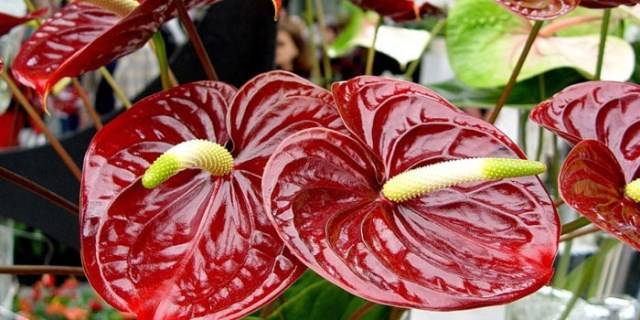
In order not to face diseases, it is necessary to immediately establish proper care for the anthurium.
What other spots can appear on anthurium and why
In addition to the fact that the leaf plates can be dry and with brown spots, due to improper care, other symptoms will appear.
Yellow spots
This symptom arises due to the influence of the following factors:
- lack of sunlight in winter;
- presence in water for irrigation of metals and their compounds, chlorine;
- rotting roots due to stagnant water.
Yellowness on the leaf plates may be due to the fact that the plant is cramped in a small pot, so it must be transplanted into a large container.
Black spots
Black bloom occurs due to drafts, low temperatures in the room and the presence of calcium salts in the soil.
White spots
The appearance of white bloom is the result of the defeat of the plant by a fungal disease, peronosporosis or powdery downy mildew. Disease occurs due to excessive moisture.
How to properly care for anthurium to avoid brown spots
In order for anthurium to please with lush flowering and a juicy, green shade of glossy leaf plates, it must be properly looked after, following a number of recommendations:
- A suitable place for a flowerpot with a plant is partial shade. Lighting should be abundant, but diffused.
- The temperature in summer is up to 25 ° C, in winter the anthurium will be comfortable at temperatures from 14 ° C to 16 ° C.
- Drafts are detrimental to the plant, they should not be.
- Watering is carried out with soft water, warm. Frequency in the summer months - 2 times a week, with the onset of cold weather 1 time in 7 days. Water is poured from the sump after 15-20 minutes.
- The humidity in the room should be high. To ensure the plant grows comfortably, it needs to be sprayed frequently.
- Top dressing is introduced 2 times a month. Mineral complex or organic fertilizers are used.
- It is recommended to do the soil yourself, mixing 1 part of peat and 2 parts of leafy soil and humus.
Anthurium is a magnificently beautiful plant with lush flowering. Despite the fact that it is considered quite capricious in cultivation, it does not require the creation of specific conditions. The appearance of blotches of a brown tint on the leaf plates indicates that the wrong care has been established for the plant. Anthurium can be reanimated if you create a comfortable environment for it and eliminate the factors provoking the disease.
